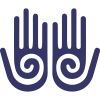So when is a good time to start thinking about your posture? And why should you care about it anyway?
The body takes its shape over years.
The problems that come from posture take decades to develop. If you have forward head posture, flat low back or hunched upper back it may take years for you to feel the effects. And the longer you had that posture, the more difficult it will be to change it. The best time to improve your posture
and prevent the consequences from developing is when you are younger, not when you are seventy or eighty and already have a Dowager’s Hump and severe back pain for example.
Posture problems are rampant in today’s society.
We spend many hours sitting and most of us sit in a way that is not conductive to the long-term health of our spine. If you take a closer look you will notice that even children nowadays are showing early
signs of forward head posture or hunched back.
Just stand up straight
So how do we start to improve our posture? If you have ever tried to do it by ‘standing up straight,’ you know that it’s not that simple. Standing up straight may work for a minute or two, or even a couple of hours, if you really focus on it. But, it’s only a matter of time before we fall back into our old postural habits.
Why is it so difficult to improve posture?
Our nervous system is involved.
Our brain has been wired to feel our current posture as the ‘normal’ posture. If you are used to have your feet on the ground with the toes pointing out, standing with the feet parallel may feel very weird. It can feel as if you are totally out of alignment. Once you become used to the pull of gravity going through your body in a certain way, that becomes the most comfortable way to move, sit and stand. But it’s only the way our nervous system perceives as a familiar hence a safe way to move.
Emotions have an impact too.
It is hard to walk with your chest broad and your head high if you feel depressed, scared or lonely. And it is equally impossible to collapse your chest and drop your chin if you feel elated. We all can read the persons emotional state by the way they look, walk and interact. Emotions play a big part in how we carry our bodies and present ourselves to the world. And they become imprinted in our posture.
Our bodies have developed compensation pattens
Once your posture goes off, the body often compensates in an effort to reduce the strain on certain parts of the body from postural misalignment. This may seem like a good solution in the short run, but in the long run, as the compensation turns into a new postural habits, it just compounds the original problem, and makes it even harder to correct posture.
With time posture becomes structure
The soft tissues and bones will gradually adjust to the forces and demands placed on them. Gestures become habits. And habits become posture. Then the posture changes our very structure.
Ageing
We lose muscle strength as we get older, and with that, we will tend to lose the muscular support system we need for proper posture.
It’s never too late to improve your posture
Postural alignment is intertwined with numerous mental, emotional, structural and physical factors. For this reason, improving our posture is not a one dimensional process. It must take into account all of these factors, and it must be a slow, gradual process of reshaping and transformation.
It is important to learn how to develop good posture habits very early on and how to improve posture, if your posture has already started to deteriorate.
The good news is that with the right approach, it is entirely possible to improve your posture. And, even better. As your posture and mental and emotional patterns are intimately connected, the process of improving posture will have a positive spillover effect into other areas of your life.
If you want to take action and start improving your posture, you can join me in my Monday online yoga class or you can book a 1-2-1 yoga to address your particular needs
Related articles:
Too much sitting – the best posture is the next posture



